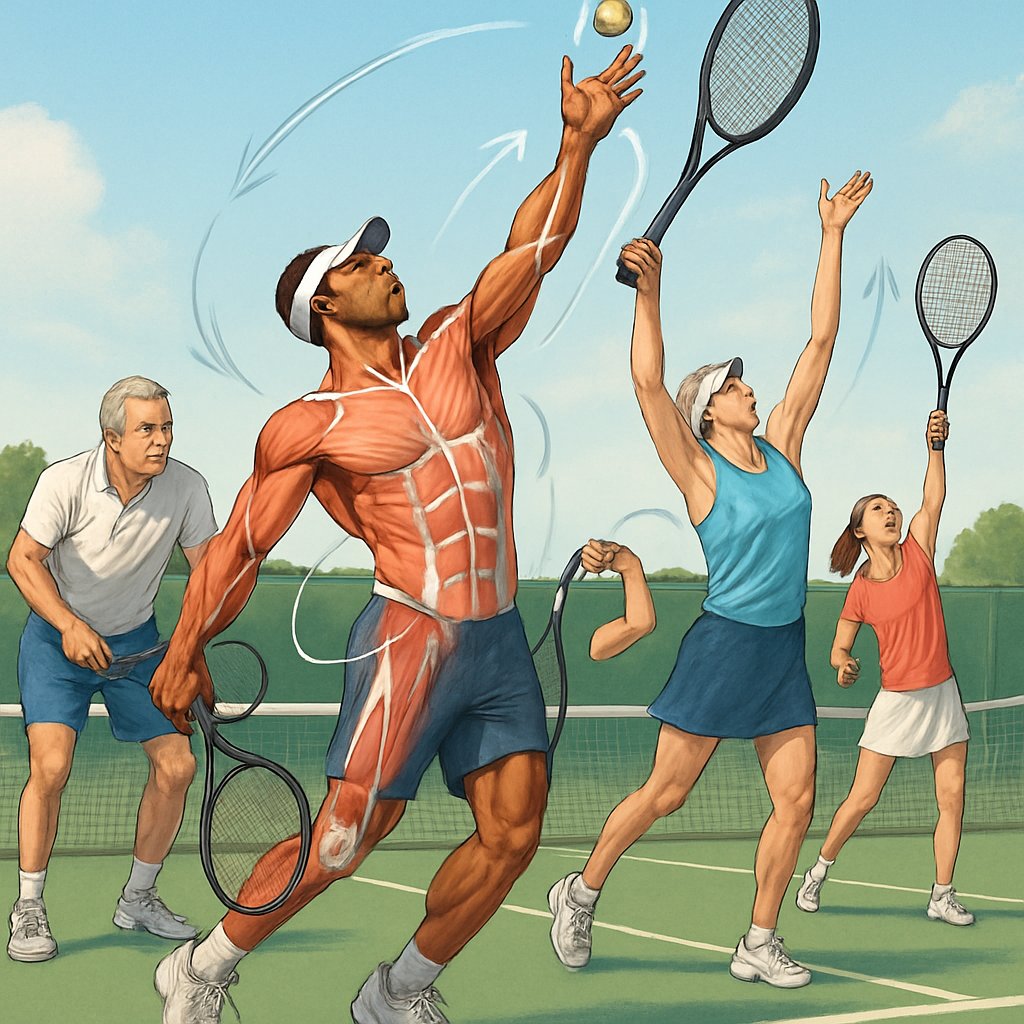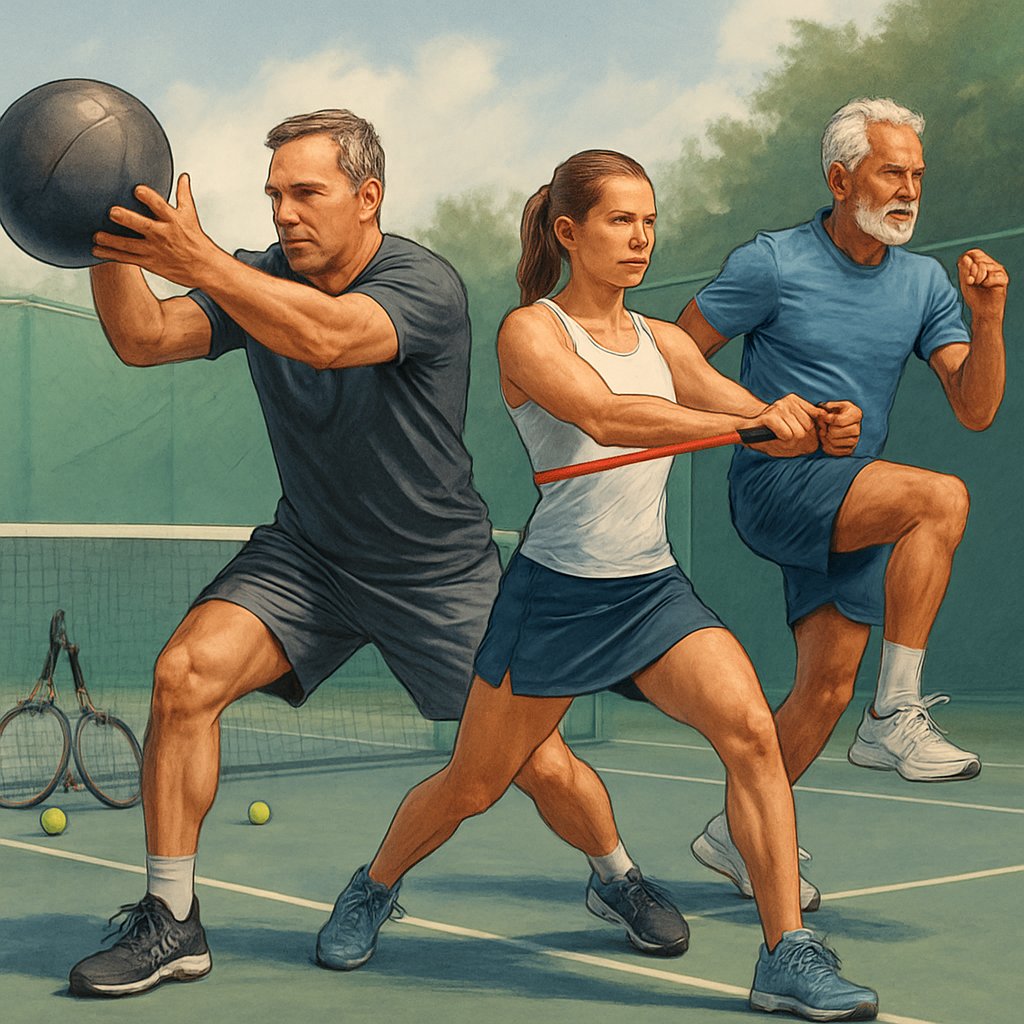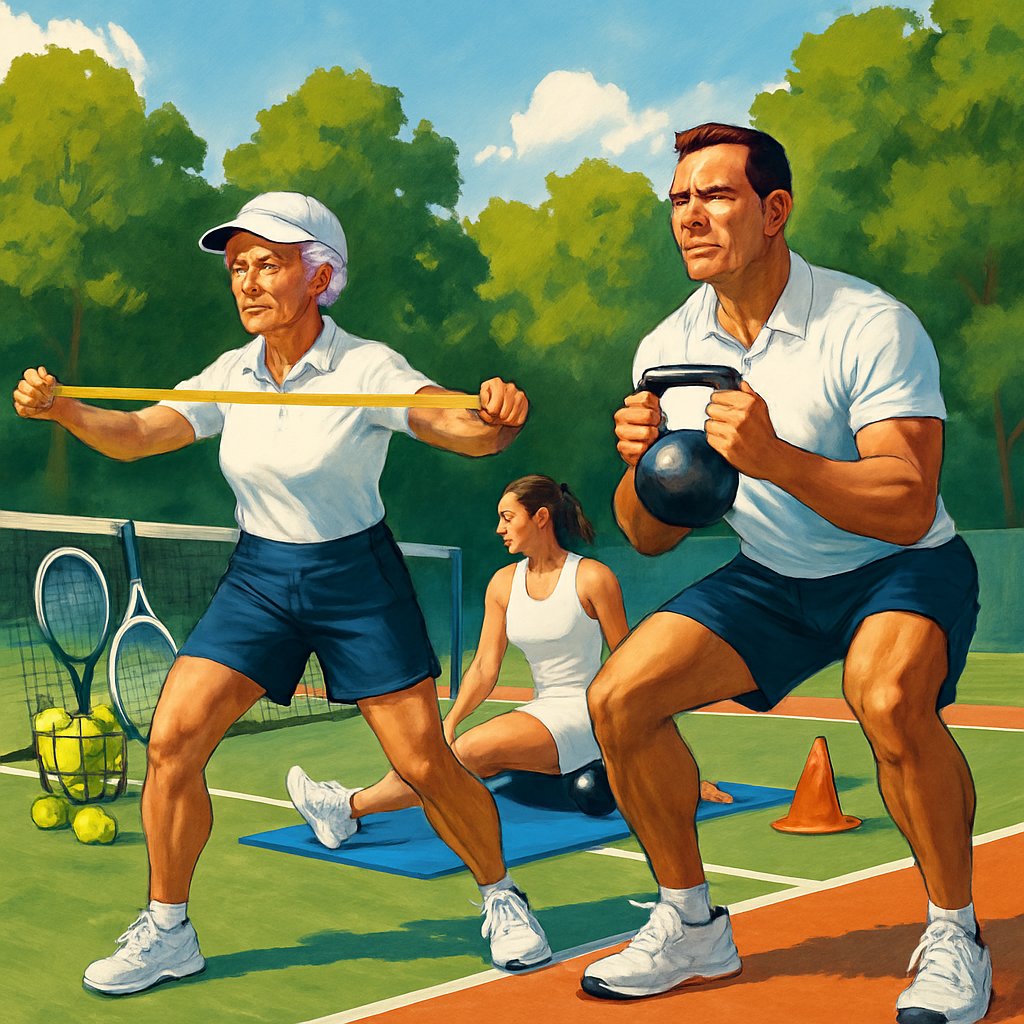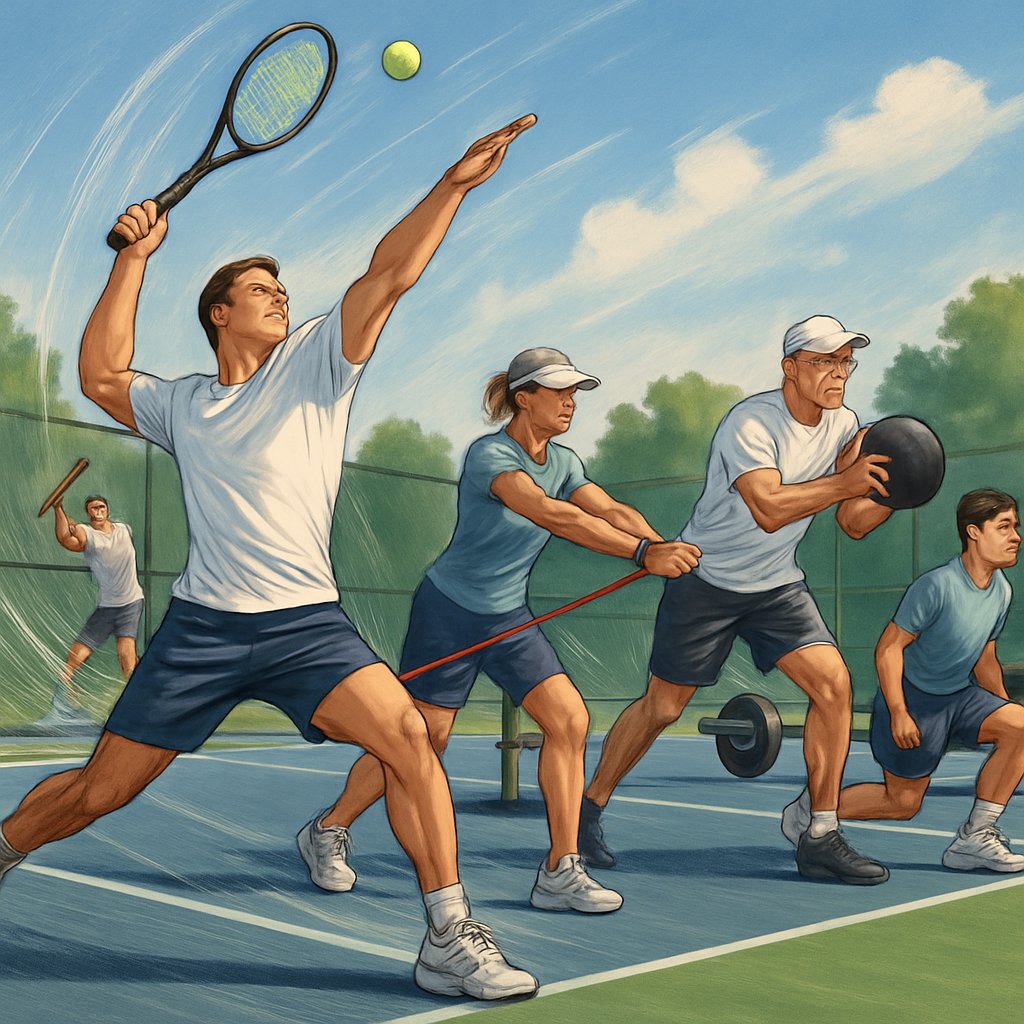A powerful tennis serve doesn’t have to fade just because you’re getting older. Lots of players assume serve speed drops with age, but you can maintain—or even boost—your velocity with the right kind of power training. You can serve harder at any age with the right techniques.

Raw strength isn’t the whole story when it comes to serving harder. Power training that emphasizes explosive movement, solid mechanics, and exercises tailored for your age can make a real difference while keeping you safer from injury.
Your body still has the potential to generate serious force. You just need to train the right muscle groups and movement patterns that actually show up in your game.
Your ability to serve harder at any age is influenced by your training regimen and commitment to maintaining physical fitness.
Key Takeaways
- Power training and good mechanics can boost serve speed at any age—you don’t need to be a bodybuilder
- Exercises and recovery routines that fit your age help you keep your serve strong and your body healthy
- Blending strength work with serve-specific drills is the best way to get a harder serve
Understanding the Mechanics of a Powerful Tennis Serve

A powerful serve isn’t just about swinging your arm fast. You need to generate explosive force through your whole body, starting with your legs and moving up through your core before it reaches your racket arm.
Understanding how to serve harder at any age is essential for maximizing your performance on the court.
The real magic happens when you create a chain reaction. Your legs kick things off, your core drives the twist, and your arm brings it all together for max speed.
The Role of Explosive Power in Serving
Explosive power is what separates a so-so serve from a real weapon. It’s not about grinding out slow, heavy movements—it’s about firing your muscles fast.
To serve harder at any age, focus on explosive movements and proper technique during training.
The entire serve motion takes less than a second. In that split-second, you’ve got to transfer as much energy as possible from your legs to the ball.
Key explosive movements:
- Quick knee bend and extension
- Rapid shoulder rotation
- Fast wrist snap at contact
Your fast-twitch muscle fibers do most of the work here. They contract with speed and force, and they’re the ones you want to train.
Plyometric exercises are your friend. They help you build that quick, explosive strength that turns into real serve speed.
Leg Drive and Kinetic Chain Activation
Leg drive is crucial to serve harder at any age, as it is the foundation for generating power.
Your legs are where it all starts. The kinetic chain begins at the ground and moves up through your body, passing energy from one segment to the next.
When you serve, you push off with your back foot and drive up with your front leg. That upward force travels through your hips, torso, and finally out your arm.
The kinetic chain sequence:
- Leg drive kicks things off
- Hips rotate and add speed
- Torso turns with the hips
- Shoulder and arm finish the job
If any link in that chain breaks down, you lose power and probably some accuracy too.
Strong legs let you drive upward and set the right trajectory. That’s where a lot of your serve’s speed comes from.
Core Strength and Rotational Force
Your core is like the bridge between your lower and upper body. If it’s weak, power from your legs never makes it to your racket.
Rotational strength is huge for serve power. Your core muscles twist your torso quickly, adding a ton of speed to the motion.
Core’s main jobs during serving:
- Stability—keeps you balanced
- Power transfer—moves energy from legs to arms
- Rotation—drives the fast torso turn
Your abs and back muscles work together for all this. The quicker and safer you can rotate, the more power you’ll get.
A strong core also helps protect your spine when you’re serving with real force. That matters more than most people realize.
Strategies to Serve Harder at Any Age
It’s possible to serve harder at any age through consistent practice and tailored power training.
Getting older throws some curveballs, but the right power training can keep your serve explosive. Knowing how aging changes your body lets you adapt your workouts and keep hitting big serves.
Overcoming Age-Related Barriers
Power fades faster than strength as you get older. After 65, lower-body power drops by about 3.5% per year on average.
Overcoming these challenges can help you serve harder at any age, ensuring you remain competitive in the game.
Muscles just don’t contract as quickly. That’s what usually slows down your serve and your court movement—not just plain weakness.
What changes with age:
- Muscle fibers fire more slowly
- Explosive power drops off
- Muscle coordination isn’t as sharp
- Energy systems get less efficient
You can fight back with the right training. Focus on moving weights fast, not just moving heavy ones.
By understanding how to train effectively, you can serve harder at any age, regardless of physical changes.
Start with bodyweight exercises. Explosive push-ups do more for tennis power than slow, heavy bench presses.
Machines can help keep things safe, especially as you get older. Seated exercises cut down on fall risk but still let you build power.
Foundations for Lifelong Progress
You need a smart plan for your power training. Try 2-3 sessions a week with rest days in between.
Having a solid plan allows you to serve harder at any age without risking injury.
How to progress:
- Weeks 1-2: Learn the movements
- Weeks 3-4: Add some light weights
- Weeks 5-6: Move everything faster
- Weeks 7-8: Combine speed and resistance
Stick with tennis-like movements. Medicine ball throws and rotational drills are great for serve power.
Train both sides of your body. Tennis tends to create muscle imbalances, so power training can help even things out.
Don’t skip recovery. Give yourself at least 48 hours between intense sessions for the same muscle group.
Set goals you can measure. Time your medicine ball throws or count how many explosive push-ups you can do in 30 seconds.
Importance of Warm-Up and Mobility
Warm-up routines are essential for those looking to serve harder at any age.
Warm-ups matter—a lot. They help you avoid injury and get more out of your power work.
Simple warm-up routine:
- Light cardio (5 minutes)
- Dynamic stretching (5 minutes)
- Movement prep (5 minutes)
Your joints need to move freely for explosive power. Tight shoulders can kill your serve speed faster than weak ones.
Try shoulder circles, arm swings, and torso rotations. They’ll get your kinetic chain ready for action.
Cold muscles don’t generate power and get hurt more easily. Even if you’re short on time, don’t skip your warm-up.
Wrap up your session with light stretching. It’ll help you stay flexible and cut down on next-day soreness.
Essential Power Training Exercises for Tennis Players
Incorporating varied drills will help you learn how to serve harder at any age.

You need to focus your training on legs, core, and shoulders to build explosive serve power. These exercises help your muscles work together and move the way you actually use them on court.
Plyometric and Lower Body Movements
Practicing specific drills can empower you to serve harder at any age.
Jump squats are a classic for explosive power. Stand with feet shoulder-width apart, squat down, then explode up as high as you can.
Land softly and drop right back into the squat. That trains your fast-twitch fibers for powerful serves.
Box jumps are next. Step onto a sturdy box with bent knees, then jump back down and repeat for 8-10 reps.
Lateral bounds help your side-to-side power. Jump sideways from one foot to the other, and hold each landing for a couple of seconds.
Single-leg hops build strength one leg at a time. Hop forward on one leg for about 10 yards, then switch. Serving uses each leg differently, so this really helps.
Core and Rotational Strength Drills
Medicine ball throws are super effective for serve power. Hold a 6-8 pound ball at chest height, rotate your torso, and throw it against a wall.
Start the movement with your legs and let the power flow through your core. That’s exactly how a good serve works.
Russian twists build up your rotational endurance. Sit with bent knees, lean back, and twist a weight side to side, keeping your core tight.
Wood chops on a cable machine hit the diagonal patterns you use in tennis. Pull the cable from high to low across your body, working both core and shoulders.
Plank variations help you transfer power. Hold a regular plank for 30-60 seconds, then try side planks or add rotations.
Upper Body and Shoulder Power Development
Overhead presses are great for building serving strength. Use dumbbells or a barbell and press straight overhead with control.
Explosive push-ups crank up your upper body power. Push up from the floor as hard as you can, trying to lift your hands off the ground.
Lat pulldowns target the muscles that snap your racket down during the serve. Pull the bar to your chest, squeezing your shoulder blades together.
Shoulder external rotations with bands help prevent injuries and build rotational strength. Keep your elbow at your side and rotate your arm outward against the band.
Incorporating Calf Raises and Leg Drive
Calf raises help build that upward leg drive you need for a strong serve. Stand on your toes, rise up as high as you can, and hold for a second.
Single-leg calf raises make it tougher. Try them on a step for a bigger stretch. Your calves give you that first push off the ground.
Jump calf raises add explosiveness. Rise onto your toes and jump up, landing softly on the balls of your feet.
Leg drive starts with basic squats. Push through your heels and extend your hips all the way up—just like you do when you serve.
Step-ups with knee drives are also great. Step onto a box and drive your other knee up high. This mimics the way you launch off the ground for a serve.
Serve-Specific Drills for Increased Power
Each drill aims to help you serve harder at any age, building both strength and technique.

These drills are all about building power without losing control. Each one challenges a different part of your serve, helping you get more explosive while staying accurate.
Progressive Distance Serving
Start close to the net and move back step by step. This helps your body learn to create more force as you get farther from the target.
Begin halfway between the service line and baseline. Hit 10 serves to each box, focusing on clearing the net with good form—not just smacking the ball.
Move back to three-quarters court. You’ll naturally swing harder to reach the box, but keep your motion smooth.
Finally, serve from behind the baseline. This teaches your body to use the whole kinetic chain for extra power.
Practice this drill twice a week. Each time, hit 30 serves at each distance and track how many land in the service box.
Practicing consistently allows you to serve harder at any age, enhancing your overall performance.
Serving Into the Back Fence
This one lets you forget about accuracy and just go for pure power. Find a court with a tall back fence or a wall.
Stand at the baseline and serve right into the fence. Swing as hard as you can while keeping your form.
Count how many balls hit the fence on the fly. That’s a good sign you’re generating real power.
Try different serve types—flat, slice, topspin. Each one uses power a bit differently.
Spend about 10 minutes on each type. Use this drill to play around with timing and explosiveness.
Targeting the Service Box with Power
Now, mix power with precision. Set up cones or targets in each corner of the service boxes.
By focusing on precision while maintaining power, you will learn how to serve harder at any age.
Serve at about 80% power toward the targets. The goal is to keep your speed up while hitting your spots.
If you’ve got a radar gun or a speed app, track your serve speeds. See if you can keep your numbers steady across targets.
Switch up your targets—wide, middle, body—just like you would in a match.
Do three sets of 20 serves, resting between sets to keep your power up.
Program Design and Recovery Strategies

You need a plan to balance tough workouts with enough rest. The trick is to train hard, recover well, and keep your tennis skills sharp.
With a balanced approach, you can continue to serve harder at any age without compromising your performance.
Sample Weekly Power Routine
Try 2-3 power training sessions per week, with at least 48 hours between them. Schedule your power work on days when tennis isn’t too demanding.
Monday: Upper body power (medicine ball throws, plyometric push-ups)
Tuesday: Light tennis or rest
Wednesday: Lower body power (jump squats, lateral bounds)
Thursday: Tennis technique work
Friday: Full body power circuit
Saturday: Match play or hard practice
Sunday: Full rest
Each power session should run about 45-60 minutes. Focus on explosive moves and take full rest between sets.
Balancing Strength, Power, and Technique
Power training should work alongside your tennis skills, not take their place. Spend about 70% of your training on tennis-specific movements.
Kick off each power session with 10 minutes of movements that feel like tennis. This way, your body links strength gains to your actual serving motion.
Training Split:
-
- 3-4 days tennis practice
Integrating power training into your routine will assist you in learning how to serve harder at any age.
- 2-3 days power training
- 1-2 days complete rest
Don’t do heavy power work on the same day as big matches. Your muscles need to be fresh for top performance.
Optimizing Rest and Recovery
How you recover shapes how well your body adapts to power training. If you skip rest, you’ll risk injury and your performance drops.
Aim for 7-9 hours of sleep each night. Muscles repair and grow the most when you’re in deep sleep.
Recovery Methods:
-
- Light stretching after workouts
- Proper hydration (try for half your body weight in ounces daily)
Proper hydration and nutrition play a role in your ability to serve harder at any age.
- Nutrition within 30 minutes post-workout
Take full rest days if you’re feeling extra tired or sore. Your body isn’t shy about asking for more recovery time.
Keep an eye on your serve speed during practice. If your power dips, it’s usually a sign you need more rest between sessions.
Frequently Asked Questions

Players looking to serve harder at any age should prioritize their training efforts consistently.
Players have plenty of questions about power training, schedules, and how to track progress in serve strength and speed.
What are effective power training exercises for improving a tennis serve?
Medicine ball throws work the explosive rotation you need for big serves. Overhead and diagonal throws both mirror serving motion.
Resistance bands build shoulder and core strength. Cable rotations help develop the twisting power your serve craves.
Plyometric moves like jump squats boost leg drive. Your legs are really the launchpad for serve power.
Dumbbell work strengthens shoulders and arms. Overhead presses and lateral raises target the muscles you use most for serving.
How can players maintain or improve serve speed as they age?
Understanding how your body changes can help you serve harder at any age while remaining conscious of your physical state.
Work on flexibility and mobility every day. Tight muscles just hold you back and sap your power.
Strength training gets even more important as you get older. Without it, muscles naturally lose power.
Recovery takes longer too. Space out your hardest sessions a bit more.
Focus on technical improvements. Sometimes, better form adds speed even when you’re not getting stronger.
Can you enhance your tennis serve without access to professional coaching?
Try video analysis to spot technique issues. Record your serves from different angles and look for patterns.
There’s a ton of free serving advice online from pro coaches. You can find breakdowns, drills, and tips with a quick search.
Utilizing available resources can assist you in learning how to serve harder at any age effectively.
Practice partners can give you instant feedback. Ask someone to watch your form and point out what looks off.
Strength training helps your serve no matter who’s coaching (or not coaching) you. With consistent effort, you’ll see gains.
Which muscle groups should be targeted to increase serve power in tennis?
Your core creates most of the rotation. Focus on your abs and obliques.
Shoulders drive arm speed and keep you stable. Train your deltoids, rotator cuffs, and upper back.
Legs are the foundation of your serve. Strong glutes and quads give you that upward push.
Forearm and wrist muscles control racquet speed. Grip strength work can really boost your ball contact power.
By targeting the right muscle groups, you can work to serve harder at any age and improve your overall game.
What is the ideal training frequency for a tennis player looking to power up their serve?
Hit strength training 2-3 times a week for solid results. This gives your body time to recover in between.
Skip intense strength work right before matches. Muscles need a day or two to bounce back.
During tournaments, back off on training volume. Keep your strength up, but don’t let fatigue pile up.
Off-season is your chance to train hard. Build your strength base when you’re not competing every week.
How does one measure progress in serve strength and velocity?
Monitoring your progress will enable you to serve harder at any age and assess your training efficacy.
Radar guns give you a clear picture of your serve speed. Lots of tennis facilities keep one around, so just ask if you can use it.
Don’t just focus on speed, though. Track how often you can hit your target—power’s not much use if the ball’s flying everywhere.
By keeping a consistent log, you ensure you are on the right track to serve harder at any age.
When you practice, jot down your fastest serves. Over time, check your monthly averages to spot any real progress.
Keep an eye on your strength training, too. If you’re lifting heavier weights in the right exercises, chances are your serve’s getting stronger.
Ultimately, the commitment to train effectively allows you to serve harder at any age.

